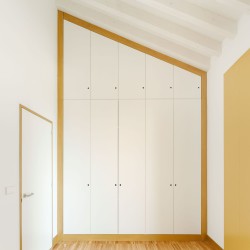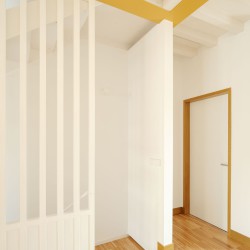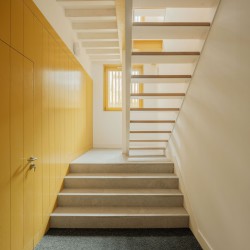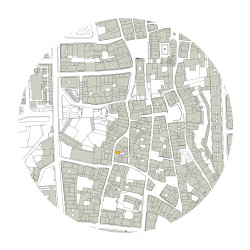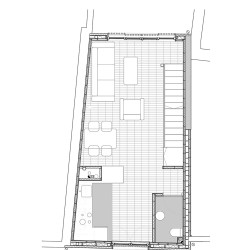Müller.Feijoo . photos: © Luis Díaz Díaz . + archdaily
The rehabilitation works of abandoned buildings in the historic centers of Galicia promoted by the public administration aim to promote the urban recovery of the most degraded historical centers of different Galician towns. These actions consist of the acquisition and subsequent rehabilitation of properties to be used for publicly-developed rental housing.
The building that we had to recover is located in one of the oldest and most degraded areas of the historic center of Ourense. It has two facades, the main one facing Rúa do Vilar and the back facing a courtyard. Before the intervention, the building had 3 floors, a ground floor for commercial use and a house on the two upper floors.
Rúa do Vilar is a very narrow street, 3.5 m. wide, with buildings on both sides, so the main facade of the house enjoys little sunlight, due to the section of the street itself and its northwest orientation. However, the courtyard to which the rear façade opens is an important outlet for the house. Its southeast orientation is a very positive value for the house since all the interior spaces will be able to receive direct sunlight throughout most of the day.
Due to the reduced dimensions of the plot, we decided to propose the construction of a single house that develops its program on the ground floor and on two upper floors. On the ground floor are the access and annexes of the house, storage room, laundry room, and facilities room. The first floor is occupied by the day area of the house open mainly towards the rear courtyard, and on the second floor is the night area formed by two bedrooms and a bathroom.
The proposed construction solutions are characterized by the use of traditional and local materials, such as the pinewood used in the structure, in the light framework system of the enclosures, and the chestnut wood of the exterior carpentry and the pavement; a very high thermal insulation, a high airtightness, a thermal installation consisting of low consumption aerothermal and underfloor heating, and controlled mechanical ventilation.
On the façade towards the courtyard, with southeast orientation and greater exposure, a wooden lattice was designed as a completely mobile solar control system that allows regulating solar radiation and overheating of the house.
As these are social rental housing, we consider it essential from the beginning of the project to reduce as much as possible the economic bill associated with the energy costs of the facilities, which future tenants will have to assume, so the final objective was to at all times, build a low-consumption building at affordable costs, with very low energy demand and an efficiency above the standards established by the regulations.
_
Las obras de rehabilitación de inmuebles en estado de abandono en los cascos históricos de Galicia promovidas por la administración publica tienen como objetivo fomentar la recuperación urbana de los centros históricos más degradados de diferentes villas y ciudades gallegas. Estas actuaciones consisten en la adquisición y posterior rehabilitación de inmuebles para destinarlos a viviendas de promoción pública en régimen de alquiler. El edificio que debíamos recuperar está situado en una de las áreas más antiguas y degradadas del centro histórico de Ourense. Cuenta con dos fachadas, la principal hacia la Rúa do Vilar y la posterior hacia un patio de manzana. Antes de la intervención la edificación tenía 3 plantas, una planta baja destinada a uso comercial y una vivienda en las dos plantas superiores. La Rúa do Vilar es una calle muy estrecha, 3,5 m. de ancho, con edificios a ambos lados con alturas medias de bajo y tres plantas, por lo que la fachada principal de la vivienda disfruta de poca luz solar, por la sección de la propia calle y por su orientación noroeste. Sin embargo, el patio ajardinado hacia el que se abre la fachada posterior supone un importante desahogo para la vivienda. Su orientación sureste es un valor muy positivo para la vivienda ya que todos los espacios interiores podrán recibir luz solar directa a lo largo de casi todo el día. Debido a las dimensiones reducidas de la parcela decidimos proponer la construcción de una única vivienda que desarrolla su programa en la planta baja y en dos plantas superiores. En la planta baja se sitúa el acceso y los anexos de la vivienda, trastero, lavadero y sala de instalaciones. La planta primera está ocupada por la zona de día de la vivienda abierta principalmente hacia el patio posterior, y en la planta segunda está la zona de noche formada por dos dormitorios y un baño. La soluciones constructivas propuestas se caracterizan por el empleo de materiales tradicionales y de proximidad, como la madera de pino empleada en la estructura, en el sistema de entramado ligero de los cerramientos, y la madera de castaño de la carpintería exterior el pavimento; un aislamiento térmico muy alto, una elevada hermeticidad al al paso del aire, una instalación térmica formada por aerotermia de bajo consumo y suelo radiante, y ventilación mecánica controlada. En la fachada posterior hacia el patio ajardinado, con orientación sureste y mayor exposición, se diseñó una celosía de madera como sistema de control solar completamente móvil que permite regular la radiación solar y el sobrecalentamiento de la vivienda. Al tratarse de viviendas de promoción pública de alquiler de carácter social consideramos primordial desde el comienzo del proyecto reducir al máximo la factura económica asociada a los gastos energéticos de las instalaciones, que los futuros inquilinos tendrán que asumir, por lo que el objetivo final fue en todo momento construir un edificio de bajo consumo a costes asequibles, con una demanda energética muy baja y una eficiencia por encima de los estándares establecidos por la normativa.











